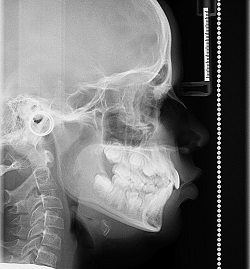Vol. 15 – Number 57 – 2022 Original article Page 80-86 Prevalence of ponticulus posticus associated with different facial biotypes in patients seeking orthodontic treatment Cesar Augusto Rodenbusch Poletto¹ Maguidieli Dallabrida¹ Bubbacar Embaló¹ Roberta Gevaerd¹ Andrei Figueiredo Ribeiro¹ Ana Lurdes Conte¹ Abstract Ponticus Posticus (PP) means “small posterior bridge” in Latin. It is defined as an abnormal bony bridge, which is generated between a posterior part of the upper articular process of the occipital bone and the posterolateral portion of the upper margin of the posterior arch of the Atlas vertebra. Objectives: the present study evaluated the effects of the variables gender, age, and vertical pattern, compared on the frequency and type of PP (partial form or complete) in a retrospective transversal sample of lateral cephalograms of healthy orthodontically untreated patients. Materials and methods: the sample included lateral cephalograms of 300 patients (n = 300) (124 men and 176 women) from a dental clinic in the city of Lages/SC. The presence of Ponticus Posticus (partial and complete) was evaluated considering gender, age, and vertical pattern. After descriptive analysis of the data, they were submitted to the chi square test (α = 0.05). Results: the overall prevalence of Ponticus Posticus was 11% (30 of 300) with its partial and complete forms verified respectively in 6.3% (19 of 300) and 4.7% (11 of 300) of the sample. No associations were found with gender (p = 0.611) and age (p = 0.761). The vertical pattern had significant relevance with the presence of PP (p = 0.007). Conclusion: there is a positive association between the vertical brachyfacial pattern type with the highest prevalence of Ponticus Posticus in its partial and complete forms. Descriptors: Etiology, Orthodontics, dental anomalies, Atlas vertebra. ¹ Dentistry – University Center Unifacvest/Lages/SC. DOI: 10.24077/2022;1557-192579
This content is restricted to site members. If you are an existing user, please log in. New users may register below.




